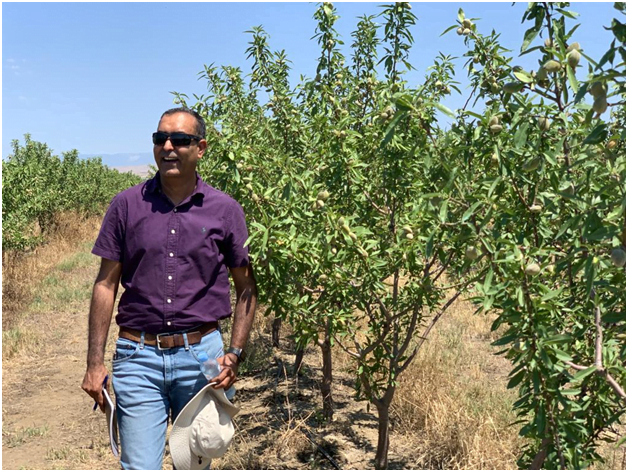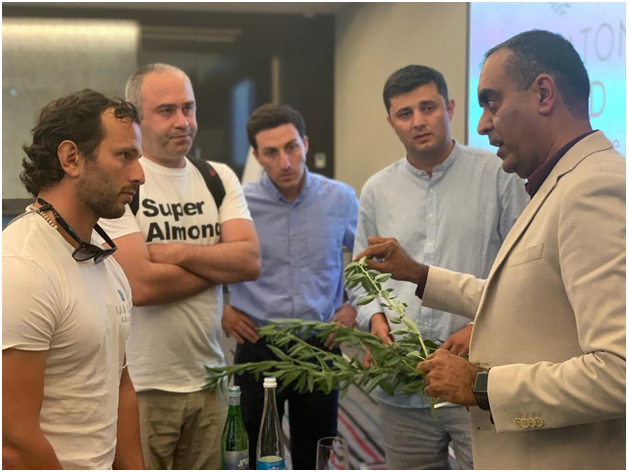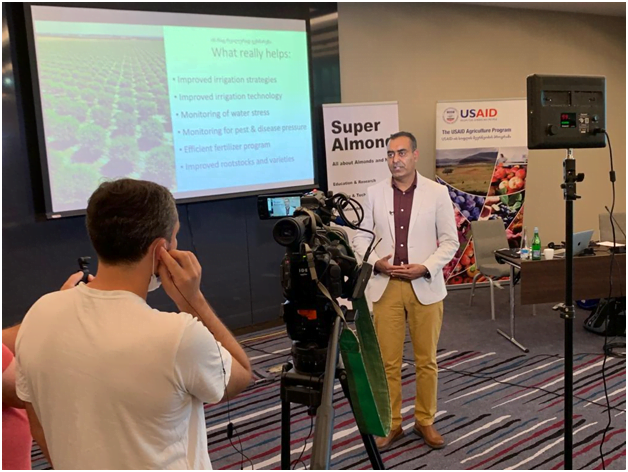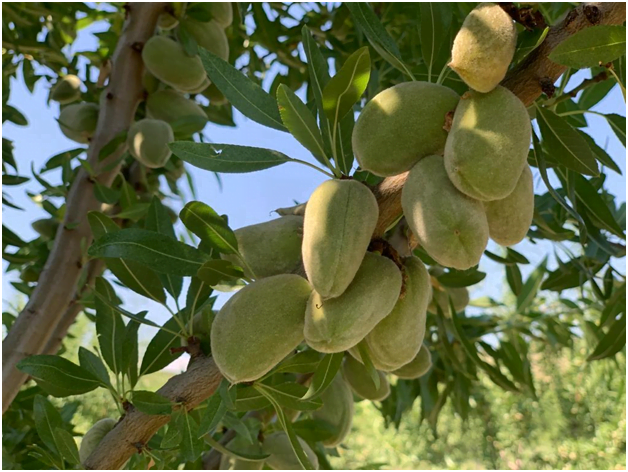In the beginning of July 2021 Super Almond with the support of the USAID Agriculture Programme has organized a weeklong training for Georgian almond growers. Dr. Gurreet Brar – Super Almond expert and a professor at the California State University, Fresno – has led the training and the field demonstrations in almond orchards in Eastern Georgia. Dr. Brar has shared his impressions and views on the developing Georgian nuts industry exclusively for EastFruit.

Dr Brar in the super-high density (SHD) almond orchard in Gardabani, Georgia
EF: Dr. Brar, being the first time to Georgia, what are your first impressions about the nuts sector here?
GB: Georgian nuts industry is in infant stage now. There are about 5000 ha of almond orchards, however, all established with the experimental approach, as decision on varieties and planting systems were made mostly relying on advice of inputs suppliers and experiences of other countries, which may have climate or soil conditions different from Georgia.
EF: what planting system would you recommend to Georgian growers – innovation of Spanish agronomists, high-density, or traditional?
GB: it depends on goals and conditions of each project, as there are lots of moving parts we must consider. Generally, increased density of trees per ha decreases time for a tree to fill its space and reach full production. As a result, high-density trees begin to produce and bring money earlier. However, increase of density requires higher initial investments per ha. Mechanization in pruning and off-the ground harvest are the biggest advantage of super-high density (SHD) system, as it helps to keep the quality and reduces risk of nuts contamination with aflatoxins. But since nuts are picked from trees, they will require additional drying. On the other hand, yield is a function of total canopy volume and light interception. Since total canopy volume in SHD system is lower than in open-center/traditional, open-center system has demonstrated better in-shell yields per tree. Currently, in the CSU Fresno we are making trials to define specifics of the SHD system, which we believe has a potential. Traditional system is still valid and equally good, as farmers who plan to have low cost, low inputs and keep small-scale operation will still benefit from it.

Training in Tbilisi
EF: what are the trends in almond varieties development currently?
GB: There is obviously a trend towards self-pollinated varieties. I would recommend Georgian growers to use late-flowering varieties to avoid spring frosts. Non-Parel is still the most popular cultivar in California, meaning in the whole almond industry, however, there are new high-producing breeds coming on the market. Some recent releases from private nurseries, from USDA and the UC breeding programs have been introduced. But they all are still early blooming in comparison with Mediterranean cultivars. There are a lot of different variety and rootstock selections that fit different processing and production needs. First, we need to focus on doing adaptive trials with various US and European varieties in Georgia. Then we will have a choice based on the intended processing and marketing need, for example whether you want to sell a hard-shell nut in-shell or sell for culinary uses etc. The choice of production system can then be based on the bearing habit and vigour of rootstock-variety combination.
Overall, when choosing the variety, you need to consider (a) blooming period to avoid wind and late frosts, (b) harvest period – to match mechanization needs and utilize market opportunities, (c) growth habit (d) soil borne issues to be considered when selecting the rootstock and (e) vigour – to efficiently use the space between trees and the rows. All these factors are important. For example, you cannot plant a vigorous variety with spreading growth habit in a super high-density design. For that reason we need a lot of data, Georgia-specific data on many cultivars and rootstocks under these climatic conditions. If we manage to generate data, we can bet on the success of the industry.

EF: what is your view on the Georgian almond sector development?
Growers must think through each step when planning investment, as it will last for the next 20-25 years. Decisions should be made based on knowledge and trials results, not emotions. To make the industry commercially oriented, it requires introducing key elements to it:
First, the industry should be built on the natural potential, which is stored in high-quality genetic material and rootstocks. Virus-free planting material should guarantee sustainable nuts production. New genetics introduction should be supported by adaptive trials by qualified professionals in the country. In the countries, where extension service has limited capacity, involving private sector through private-public partnership for testing new fruits varieties has demonstrated quick results. Super Almond is working to provide the US knowledge and experience in the nuts sector of Central Asia and Caucasus region. We are also suppliers of quality genetic materials for propagation for nurseries. I believe this system will work well in Georgia in cooperation with the Scientific research center.

Georgian growers are thirsty for knowledge. If they have a possibility to use study materials of the University of California available online, there is gap of the applied practice, which we were trying to spot and fill in during this visit. Thus, I see the potential for cooperative extension system, which should be industry-funded. The system should be built on local advisors/agronomists, who will be close to growers, consulting them on daily basis, like a family doctor; and senior advisors– both local and international – who will provide guidance on very specific directions, like a cardiologist or a virologist. To make this system fully operational and show results from decisions made based on knowledge, 3-4 years of work are needed. The sooner we start, the better it will be for the industry. Currently, we seek support of donors for this exciting project, because all activities are not sustainable without extension system. As a scientist, I see great learning possibilities for the US students in Georgia, thus in the nearest future we will organize knowledge exchange activities for American students from the University Fresno to Georgia to support research as part of our extension program. During my visit I have met and interacted with a number of young, energetic agronomists who are passionate about getting knowledge and applying it, which is encouraging. We need to channelize that spirit and provide guidance.
The third pillar is of course, sales. Free trade agreements between Georgia and EU, China, Commonwealth of Independent States and Turkey would help. However, considering high competition on the market, processing infrastructure is absolutely crucial for delivering high-quality product. As in other nuts, aflatoxins are an issue in almonds and it ties back to good management practices. Therefore, we consider further capacity building within Super Almond programme.
In California water is a serious problem: both availability and quality. With the recent drought, many older almond orchards are being removed and those will likely not be replaced by almond orchards. Farmers are moving towards more drought and salt tolerant crops like pistachios. In my opinion, the bearing almond acreage in California will be reaching a plateau. With the increasing demand of various almond products worldwide, the almond industry is expanding to Europe, Australia and South America. We in California still contribute a huge share to world almond production and produce great quality kernels, but places like Georgia have great potential to produce to meet increasing demand.
The use of the site materials is free if there is a direct and open for search engines hyperlink to a specific publication of the East-Fruit.com website.




